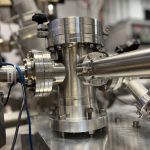Large UHV scattering instrument, aimed at performing surface dynamics experiments (diffusion, phonon dynamics, dissipation, etc.).
First generation helium microscope. Typically used for ongoing high-resolution imaging.
Second generation advanced helium microscope, used for technique development and imaging.
Small UHV vacuum system aimed at performing structural HAS measurements using diffraction and diffuse scattering, and for preparatory work prior to Spin-Echo experiments.


If you are new to CORDE we would recommend contacting us via the form below to ensure we can help you with a detailed response. Or you can contact the Atom Scattering Facility Scientist directly at atom.scattering@corde.phy.cam.ac.uk.
Anton Tamtögl; Emanuel Bahn; Marco Sacchi; Jianding Zhu; David J. Ward; Andrew P. Jardine; Stephen J. Jenkins; Peter Fouquet; John Ellis; William Allison
Motion of water monomers reveals a kinetic barrier to ice nucleation on graphene
In: Nature Communications, vol. 12, pp. 3120, 2021. doi:10.1038/s41467-021-23226`.
The interfacial behaviour of water remains a central question to fields as diverse as protein folding, friction and ice formation. While the properties of water at interfaces differ from those in the bulk, major gaps in our knowledge limit our understanding at the molecular level. Information concerning the microscopic motion of water comes mostly from computation and, on an atomic scale, is largely unexplored by experiment. Here, we provide a detailed insight into the behaviour of water monomers on a graphene surface. The motion displays remarkably strong signatures of cooperative behaviour due to repulsive forces between the monomers, enhancing the monomer lifetime ( ≈ 3 s at 125 K) in a free-gas phase that precedes the nucleation of ice islands and, in turn, provides the opportunity for our experiments to be performed. Our results give a molecular perspective on a kinetic barrier to ice nucleation, providing routes to understand and control the processes involved in
ice formation.
Anton Tamtögl; Marco Sacchi; Nadav Avidor; Irene Calvo-Almazán; Peter SM Townsend; Martin Bremholm; Philip Hofmann; John Ellis; William Allison
Nanoscopic diffusion of water on a topological insulator Journal Article
In: Nature Communications, vol. 11, no. 1, pp. 1–9, 2020. doi:https://doi.org/10.1038/s41467-019-14064-7
The microscopic motion of water is a central question, but gaining experimental information about the interfacial dynamics of water in fields such as catalysis, biophysics and nanotribology is challenging due to its ultrafast motion, and the complex interplay of inter-molecular and molecule-surface interactions. Here we present an experimental and computational study of the nanoscale-nanosecond motion of water at the surface of a topological insulator (TI), Bi2Te3. Understanding the chemistry and motion of molecules on TI surfaces, while considered a key to design and manufacturing for future applications, has hitherto been hardly addressed experimentally. By combining helium spin-echo spectroscopy and density functional theory calculations, we are able to obtain a general insight into the diffusion of water on Bi2Te3. Instead of Brownian motion, we find an activated jump diffusion mechanism. Signatures of correlated motion suggest unusual repulsive interactions between the water molecules. From the lineshape broadening we determine the diffusion coefficient, the diffusion energy and the pre-exponential factor.